Casting our minds back to this early post, we now all know how Rob decides it’s time to pick his grapes. But how are they physically picked?
The romantics amongst us probably imagine they’re all lovingly picked by hand… gently placed into baskets and carried to the winery by dedicated but carefree workers basking in the glow of the late summer sun. No? Just me?
Well, traditionally grapes have always been picked by hand (I may have taken a little creative licence with the carefree basking). These days though, we also rely pretty heavily on machinery.
But it all depends a bit on the variety and style of wine.
Let’s take a closer look at each method and find out exactly what Rob does with his grapes…
Picking by hand
Hand-picking is obviously the gentlest way to handle grapes at harvest time. It allows the removal of whole bunches – leaving the berries attached to the stalks.
Mechanical harvesting
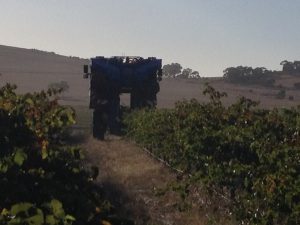 Mechanical harvesters work by moving along the row and shaking the vines. This movement causes the berries to fall off their stalks.
Mechanical harvesters work by moving along the row and shaking the vines. This movement causes the berries to fall off their stalks.
There are several benefits to using machine over hand-picking. Firstly, and most obviously, it allows grapes to be picked at a fraction of the cost and time. This can be really important 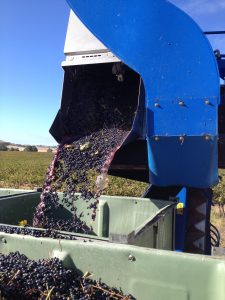 when the grapes have reached their desired ripeness and need to be removed quickly. Secondly, these machines can pick through the night when temperatures are cooler. As we know, oxidation can occur at higher temperatures, so picking at night is often a better option if daytime temperatures are high. Ideally, grapes should be picked at an ambient temperature of between 8 and 16 degrees Celcius.
when the grapes have reached their desired ripeness and need to be removed quickly. Secondly, these machines can pick through the night when temperatures are cooler. As we know, oxidation can occur at higher temperatures, so picking at night is often a better option if daytime temperatures are high. Ideally, grapes should be picked at an ambient temperature of between 8 and 16 degrees Celcius.
So why pick by hand at all?
There are a few situations for which mechanical harvesters cannot be used…
Some vineyards are simply inaccessible to heavy equipment. Steep slopes can make mechanical harvesting impossible.
In other cases, the winemaking technique dictates the use of whole bunches. For example:
- in the production of premium sparkling wine where whole bunch pressing is used to extract the juice
- When red wines are made using carbonic maceration
- Where there is a need to select only certain bunches or parts of bunches due to the presence of disease.
Carbonic maceration is a winemaking technique in which whole grapes are fermented in a carbon dioxide rich environment prior to crushing. The result are wines that are fruity in aroma and flavours, sometimes with a distinct banana aroma. They lack tannins, and deep color. Carbonic Maceration is most commonly practiced in Beaujolais with the Gamay grape, which has thin skins and produces lots of fruity aromas and flavours.
So which method does Rob use?
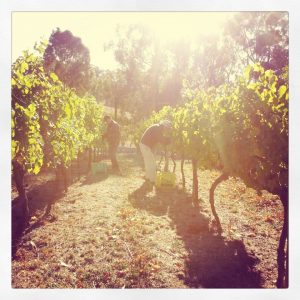 Rob always hand picks his Pinot Noir for Sparkling and Rose along with his Sauvignon Blanc.
Rob always hand picks his Pinot Noir for Sparkling and Rose along with his Sauvignon Blanc.
The main principle is to finish up with fine, delicate, low colour juice. The tannins also need to be low. Since colour, tannins and compounds leading to a bigger bodied juice/wine are in the skins, it makes sense to keep berries/skins intact until the bunches get to the press. Machine harvesting always causes rupture of skins and release of juice, no matter how well it’s done.
For red wines and bigger bodied whites such as Chardonnay, this extra extraction is not a problem, so all the varieties for dry red (Shiraz, Tempranillo and Pinot) are machine harvested. It’s also beneficial for Chardonnay to be machine picked as it helps to give bigger body, and the slight extra tannin is easily absorbed with the barrel ageing.
Looking for something to do this weekend?
Why not come to Somerled for a welcome glass of red (or two) near the courtyard fire pit, before rolling up your sleeves with us for a fabulous, instructional and semi-hands-on sausage making day. That’s right… join us and the Gepetto’s boys who will teach you how to make cured Italian sausage!
Great fun for under 18s too.
Saturday 21 July 2018 at 11:30am
Tickets via https://www.trybooking.com/book/event?eid=397757
ADULTS: $150pp all-inclusive!
UNDER 18’s: $80pp
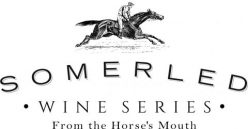
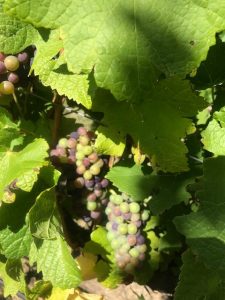 That said, there is still plenty happening…
That said, there is still plenty happening…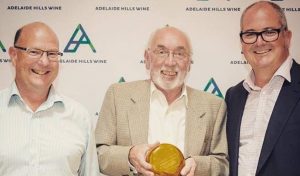
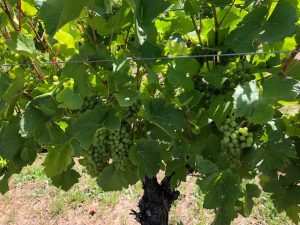 Vines looking good even after the heat of the past week. They look fresh and the leaves are glossy. The nighttime temperatures have been really low since the two or three very hot days over the weekend, which helps. The vines on the block we pick the grapes for the sparkling are “dry grown” and get no irrigation at all (unless they absolutely need it – the grower has a bore).
Vines looking good even after the heat of the past week. They look fresh and the leaves are glossy. The nighttime temperatures have been really low since the two or three very hot days over the weekend, which helps. The vines on the block we pick the grapes for the sparkling are “dry grown” and get no irrigation at all (unless they absolutely need it – the grower has a bore).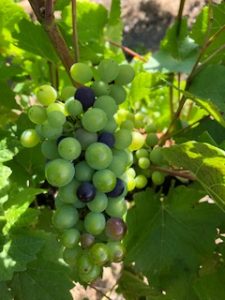 and are still hard as nails. Almost no sign of
and are still hard as nails. Almost no sign of